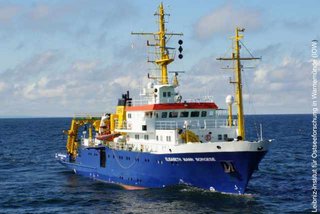Oxygen is essential for the development of higher life. However, it was hardly present in the oceans of the young Earth. It was not until the evolution of photosynthetic bacteria that the oceans saw a significant increase in oxygen levels. By measuring tungsten isotope composition, an international research team with the participation of scientists from the University of Cologne’s Institute of Geology and Mineralogy has now laid the foundation for a more precise determination of the development of oxygen levels in the early oceans over time. Prospectively, they expect more precise insights into the evolution of life. In cooperation with scientists from ETH Zurich, the Universities of Bern and Tübingen, and the Leibniz Institute for Baltic Sea Research Warnemünde (IOW), geologists led by Dr Florian Kurzweil at the University of Cologne analysed the chemical element tungsten, which could act as an indicator element for oxygen, in today’s seawater. The results have been published in the Proceedings of the National Academy of Sciences (PNAS) under the title ‘Redox control on the tungsten isotope composition of seawater’. The research is part of the German Research Foundation’s priority programme ‘Building a Habitable Earth’.
Tungsten is present only in very small amounts in the oceans, making it difficult to accurately determine its concentration. It is even more difficult to determine the abundance of individual tungsten isotopes in seawater. Isotopes of an element have the same number of protons, but different numbers of neutrons. Hence, there are heavy tungsten isotopes with many neutrons and lighter tungsten isotopes with fewer neutrons. The analytical methods developed at the University of Cologne enable the most precise measurement of relative tungsten isotope abundances currently available worldwide.
In a basin more than 400 metres deep in the Baltic Sea, the research team took various water samples, both in the oxygen-rich surface water and in the oxygen-deficient deep water. Oxide minerals form along the boundary of both water layers, preferentially binding the light tungsten. The tungsten remaining in the seawater thus becomes relatively heavier. Oxygen is required to form oxide minerals, so the oxygen concentration of the oceans ultimately correlates with the tungsten isotope composition of the seawater.
‘Increasing oxygen concentrations in the oceans of the early Earth should have led to increased formation of the oxide minerals, and thus to isotopically heavier marine tungsten,’ said the head of the research expedition Dr Florian Kurzweil. The scientists now want to show that this development has been preserved in marine sediments. The composition of tungsten isotopes of the oldest sediments on Earth could then trace the development of marine oxygen levels over the course of Earth’s history like a genetic fingerprint.
Media Contact:
Dr. Florian Kurzweil
Institute of Geology and Mineralogy
+49 221 470 89864
Press and Communications Team:
Eva Schissler
e.schisslerverw.uni-koeln.de
+49 221 470 4030
Publication:
https://doi.org/10.1073/pnas.2023544118
